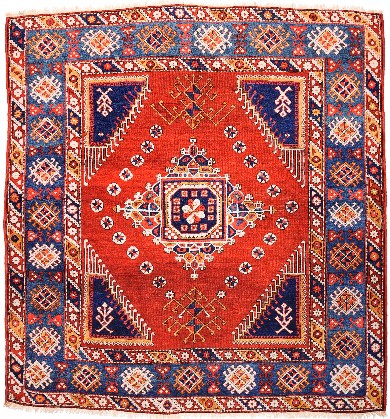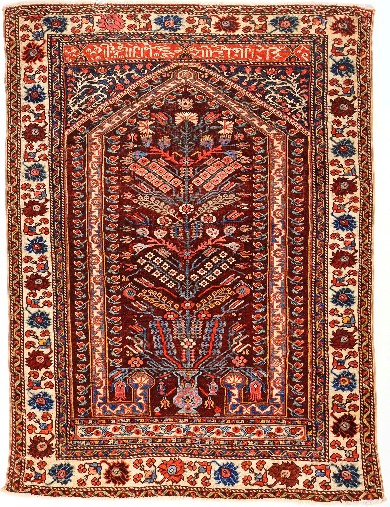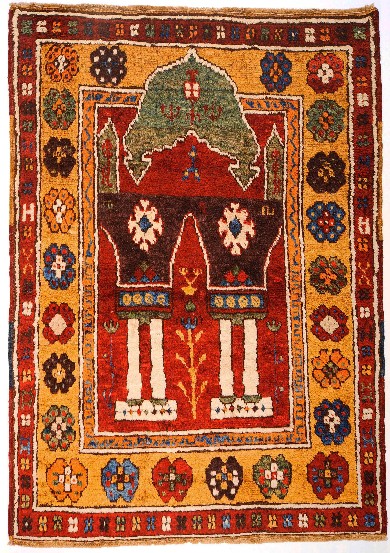|
WOVEN PARADISE EXHIBIT FEATURES GERMAN COLLECTOR'S ANATOLIAN RUGS

Although Renaissance artist Ghirlandaio painted a similar rug design, this 18th century Bergama rug is uniquely Buddhist-inspired with the pillar of the world rising up perpendicularly from its center. 207 x 197 cm; 812 Knots/dm². All rugs shown copyright Martin Posth Collection.
|
BERLIN -- Collector Martin Posth, author of "Collected Beauty," a highly respected book on Anatolian rugs and kilims published in 2014, will present a selection from his extensive collection in an exhibition at Berlin's Studio Bumiller from Oct. 23 - Dec. 3, 2016. Forty-three Anatolian rugs and 13 kilims from the 18th and 19th centuries will be shown at the exhibition entitled, Woven Paradise: A journey through the Anatolian Textile Craft of the18th and 19th Centuries.

Within the prayer niche of this Kömürcü-Kula rug is a vase with a tree of life growing out of it and carrying an endless array of blossoms and flowerage. 135 x 100 cm, 18th century; 2160 Knots/dm²; © Martin Posth Collection
The exhibition highlights the centuries-old history of carpet knotting and the influence diverse cultures have had on the Turkish-Anatolian region. At the same time, it offers an overview of the different types of Anatolian rugs and kilims, introducing the viewer to their world of color, ornamentation, variety of design and symbolism. The exhibition displays prayer rugs and nomadic rugs, funeral rugs, rugs from Anatolia's Christian communities, and full pile carpets which served as beds.
The bridging of Islam and the followers of other faiths (Christians and Jews, Armenians and Kurds) is a hallmark of the Ottoman Empire, and with this in mind, the exhibition aims at promoting, and contributing to, a constructive exchange between cultures. "The exhibition can help facilitate a better understanding of our fellow citizens of Islamic heritage, thereby allowing us to encounter them more respectfully," says Martin Posth.
Martin Posth Collection
Just as with classic star designs, nomads also created star motifs in tribal patterns as evidenced in this Kozak-Yıldız (Star Kozak) knotted rug. 100 x 110 cm; 19th century; 540 Knots/dm²; © Martin Posth Collection
A fervent and passionate collector, Martin Posth has spent over 35 years compiling this collection of Turkish textiles. It was more a matter of chance that led him to become a collector of these historic textiles – mainly rugs and kilims. His great-uncle, Berlin native who had moved from Cairo to Istanbul as a banker, and had remained there for the rest of his life, made Posth the executor of his will, which in turn led him to acquaint himself with antique rugs.
The unique pieces, all of which originated in the 18th and 19th centuries, bear witness to the exceptional craftsmanship of Anatolian rug making and illustrate the artistry inherent in this textile craft.
Craft
Features in this Megri knotted rug such as these Hyacinth blossom motifs on stairway-like branches are only seen in rugs from Megri. 180 x 100 cm; First half of the 19th century; 640 Knots/dm²; © Martin Posth Collection
The knotting and weaving of a rug by hand has a very long, approximately 5,000 year old tradition. The completion of a rug can take weeks or even months. The manufacturing of the textiles has traditionally been a woman's domain, and it is they who pass on their knowledge to the following generations. Cotton, wool or silk were most commonly used, but production also saw the use of mohair or thick, shaggy wool threads.
Designs and Symbolism
Showing its Transylvanian influence, this Gördes oder Kula knotted rug features a mask in its archway instead of the expected hanging lamp, and cottage motifs of diamond chains and water jugs instead of architectural elements. 174 x 120 cm; 18th century; 1483 Knots/dm²; © Martin Posth Collection
Anatolian rugs and kilims include an extremely vibrant spectrum of designs and symbolism, featuring a variety of plants and flowers, geometrical figures, religious and spiritual motifs.
Over time and through the influence of other cultures, further patterns and decorations were added, so that traces of Kurdish, Armenian, Greek, Caucasian and Byzantine peoples can be found in the designs. The motifs and designs of the rugs and kilims therefore allow the visitors of the exhibition to also trace Asia Minor's diverse ethnic and political history.
Catalog
The exhibition will be accompanied by a comprehensive and high quality catalogue, presented both in German and English: Woven Paradise - A journey through the Anatolian textile craft of the 18th and 19th centuries. Self-published by Dr. Martin Posth. Price: E 29.90. ISBN 978-3-00-053301-3.
Georg Butterwerk (Vienna), internationally recognized expert for Anatolian textile crafts, is responsible for producing the catalogue.

A field featuring raised pillar bases and poppy shrubs replaces the expected roof design with a spiked helmet in this Konya - Ladik knotted rug. 142 x 106 cm; Second half of the 19th century; 400 Knots/dm²; © Martin Posth Collection